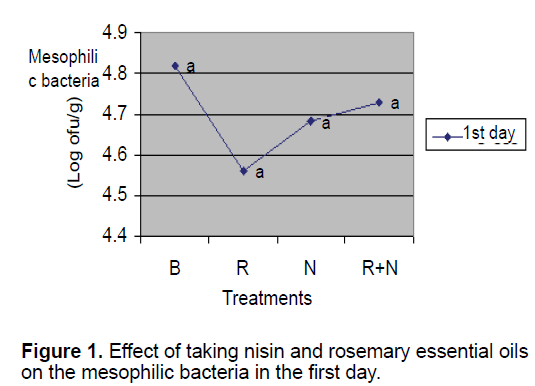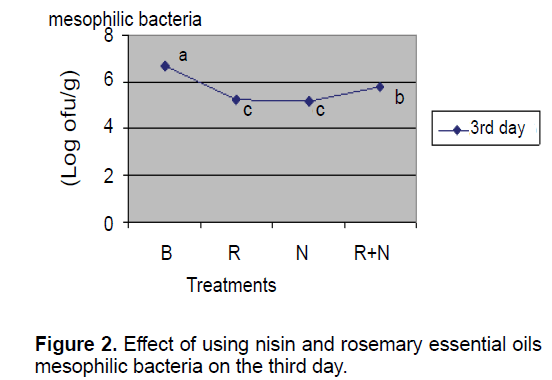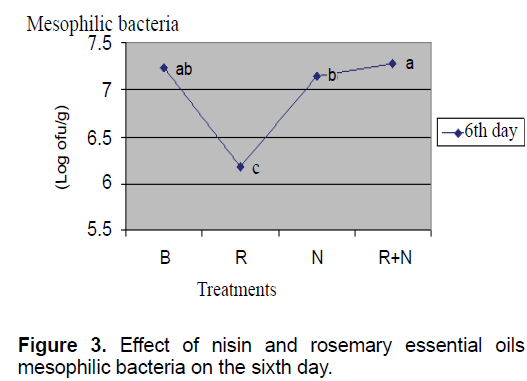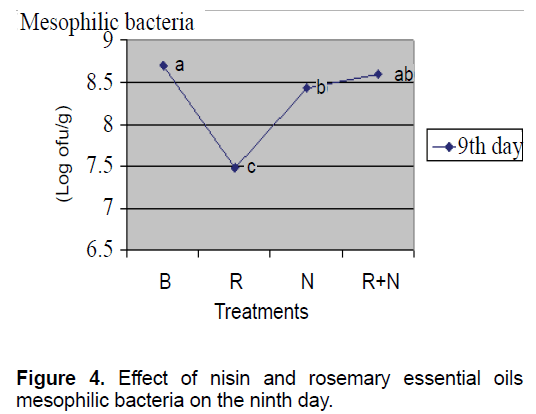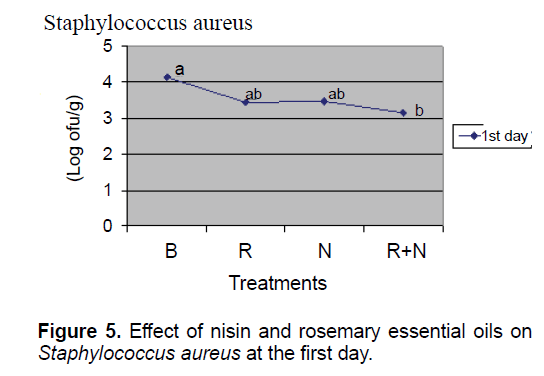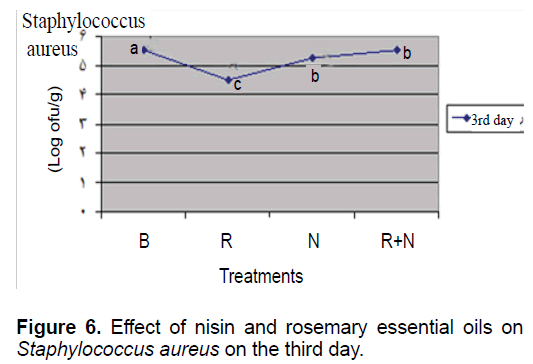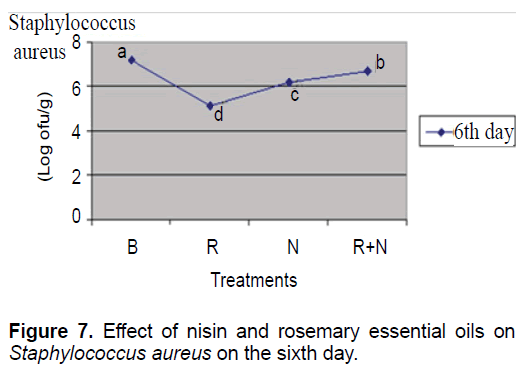Effect of Using Nisin and Rosemary Essential Oil on Total Number of Mesophilic Bacteria and Staphylococcus Bacteria in Farmed Common Carp Fillets Stored at 4ÃÆââ¬Å¡ÃâðC
Andisheh Rezaei, Mahshid Shamloofar
Andisheh Rezaei1,* and Mahshid Shamloofar2
1Department of Food Industry, Azadshahr Branch, Islamic Azad University, Azadshahr Iran;
2Department of Fisheries, Azadshahr Branch, Islamic Azad University, Azadshahr Iran.
Received: June 07, 2016; Accepted: June 27, 2016; Published: July 05, 2016
Citation: Rezaei A, Shamloofar M. Effect of Using Nisin and Rosemary Essential Oil on Total Number of Mesophilic Bacteria and Staphylococcus Bacteria in Farmed Common Carp Fillets Stored at 4°C. Electronic J Biol, 12:4
Abstract
The high corruptibility of fishes has caused the maintenance of the quality of fresh fish becomes one of the major issues of concern in the fish industry and consumers. In this paper, the effect of nisin (2.5%) and Rosemary (1.5%) on conventional breeding carp was examined at 4°C. Investigated parameters during maintenance time included of microbial factors (psychotropic and Staphylococcus bacteria), studied at 0, 3, 6, 9 times. Results indicated that TVC and Staphylococcus aureus content of the control sample exited the standard range after 9 days and in the case of the sample containing preservatives, it remained in the standard range up to 9 days (P<0.05%). The results of microbiological analysis showed that the use of rosemary extract oil increase the shelf life of a common shelf life of framed carp at 4°C temperature up to 9 days.
Keywords
Common framed carp; Nisin; Rosemary extract; Staphylococcus aureus bacteria; Shelf-life.
1. Introduction
According to the reports of World Health Organization, more than 30% of the population in industrialized countries suffers from food-borne diseases yearly [1]. Staphylococcus can be present in most or all foods which are directly manipulated by humans, especially in the case of saline products regarding their resistance to salt and growth in low moisture content media, where there is a high risk of food poisoning [2].
To prolong the shelf life of foods and prevent the growth of bacteria, chemical methods are frequently used. But today, scholars emphasized on the less application of such approaches, because consumers tend to use products with longer shelf life with the lowest change of structure and on the other hand, the carcinogenicity and toxicity characteristics of some additives have been obvious for the human [3].
Therefore, pressures have been raised on the food industry authorities for fast replacement of chemical preservatives and use of natural preservatives as one of the novel strategies for improvement of the health aspects of foods and increase the public health of the society [4].
Nisin (polypeptide which is created by certain strains of lactococcus bacteria during the fermentation), is one of the natural preservatives which inhibits the growth of many Gram bacteria. By partnership of the FDA and WHO in 1969 Osl, nisin was turned to safe additive for use in food and this biological preservative was also added to the list of food additives in Europe [5].
The antioxidant activity of rosemary extract is known since about 30 years ago. During this period, so many research articles have been taken on this plant as all of them approved its antimicrobial and antioxidant properties. Carnosol is the most important activate ingredient in rosemary extract.
Other phenolic compounds such as epi-rosmanol and ISO-Rosmanol also carnosic acid and rosmatic acid were extracted from the leaves of rosemary [6]. Due to the necessity of using non-harmful preservatives for consumers of container and corruptibility of some food products such as meat, fish fast, finding the useful preservatives for reducing the microbial load of these products is necessity for promotion of food hygiene in societies.
Therefore, the purpose of this study is to examine the effect of different concentrations of nisin solution and rosemary on the growth behavior of the Staphylococcus aureus bacteria, as one of the most important food-borne bacteria in fresh muscle of common carp, which was kept in improper refrigerated conditions.
2. Materials and Methods
2.1 Preparation of fish samples
The study was conducted in the fall of 2013 at the Institute of Aquatic Ecology of the Caspian Sea in the city of Sari. New Breeding of common carp caught with an average weight of 1,500-1600 were purchased from the farm in Sari and moved quickly to the laboratory research while being keeping in ice bath.
During the time less than half an hour washing, head and tail were cut and discharge of offal was performed. Then fishes were fillets with average weight of 5 ± 50 g and rinsed again.
2.2. Design of experiment
The test included of 4 treatments and 2 replicated trials. The treatments involved rosemary (1.5%) and nisin (0.5 g/Kg) and the combination of nisin and rosemary and a control group that does not contain any additives. Then, the effectiveness of each of them was evaluated at different times (0, 3, 6 and 9 days) were evaluated.
2.3 Preparation of samples containing nisin
In order to prepare treatment samples containing nisin, 0.05 g per 1 ml of nisin solution was dissolved in 0.02 N Hydrochloric acid (Merck, Germany), and sterilized by filtering within 0.45 μm filter. Then a desired quantity was removed and added to dishes containing sterile distilled water. After mixing at a concentration of 0.5 g/kg, it was sprayed on fish fillets [6-8].
2.4 Preparation of the sample containing rosemary
In order to prepare 1.5 ml of Rosemary extract oils, Rosemary was dissolved in 100 ml of distilled water and then using a sampler it was distributed uniformly in the fillet based on treatments.
2.5. Activation of Staphylococcus aureus bacteria
In order to activation, bacteria was cultured in Lyophilized in brain-heart environment at 35°C for 16-18 h (overnight) and were cultured for at least two consecutive times. Then considering the number of bacteria was done per mm of second cultivation and repeated for at least three times. Finally, the number of bacteria was determined in each mm.
The last culture was done to be used in future studies, prepared by 1 to 5, mixed with 50% glycerin and kept at volumes of 1 mm eppendorf micro-tubes stored at -20°C. Every time, the culture stored at -20°C was used for taking the experiment.
2.6. Preparation of the bacterial inoculum
Preparation of the inoculated test bacteria was taken by bacteria transformation from the microcentrifugation eppendorf tube to the broth (BHI) environment and maintenance was carried out for 18 h at 37°C.
Again, the second culture of the initial 18 h, was prepared in another broth (BHI) (for 18 h at 37°C) and then cuvette tubes containing 5 mm sterile broth were prepared. Different values of broth culture prepared at second 18 h were isolated by cuvette tubes.
Using a spectrophotometer (Milton Roy company USA) at a wavelength of 600 nm, the absorption of these tubes were read. Thus, for each time of test (to determine the logarithm of probability percent of growth), by revealing the optical adsorption, approximately 107 bacteria per mm (which was also confirmed by pour plate culture), the cuvette tube containing approximately 107 bacteria per 1 ml was specified. Then, 1 mm of the cuvette solution was taken and mixed with 39 mm of sterile peptone water, as finally 2.5*10^4 bacteria were existed Per 100 μL of contents of glass zemax (this number was confirmed by culturing on agar).
Now, at the time of inoculation of cutting carp, 100 μL of zemex bottle contents were used containing 1 × [10]^3 bacteria were.
Staphylococcus bacteria in such value was added to all treatments of samples. The samples were then massaged to ensure thorough mixing of bacteria with fish fillets. Then the samples were packed by MAP method at a temperature of 4 ± 400ºC and hold for 9 days.
3. Analysis of Microbial Load
3.1. Sample preparation
In order to analyze the microbial load, first using scalpel and sterile forceps, 10 g of fillet was removed and mixed by 90 ml of sterile saline serum and homogenized for 60 s in a laboratory mixer.
3.2. Total plate count (TPC)
In order to determine the total count of bacteria in different treatments, the national standard method (No. 8923-1) was used.
Preparation of decimal dilutions is essential for microbial count. The first dilution is one-tenth shown as 10-1. For preparation of one-tenth dilution, about 10 g of fish was weighed and cut.
Then 90 ml of proper diluent was added. So a homogenous mixture of sample with 0.1 of dilution was obtained.
To dilute the sample, the required numbers of tubes containing 9 ml of diluent fluid were specified by 0.01, 0.001, 0.0001, 000, respectively and then with the help of a 1mm sterile pipette, one ml of 0.1 dilution was isolated and added to the first tube containing a liquid diluent marked by 0.01.
The 0.01 dilution tube was shaken well, and then using another 1 ml pipette, one ml was added to the tube containing diluent solution, marked as 0.001, and the dilution was continued. It should be noted that each pipette should be sunk in one dilution and never meets other concentrations. All the above actions should be done besides the flame and by observing sterile conditions. Peptone water diluent was used in this case.
Culturing method used in this experiment was the Plate Count Agar method (PCA) (Merck, Germany). In this way, a liter of distilled water was heated to boil then it was sterilized at 121°C for 15 min. Using a one ml pipette, one ml of the most diluted solution was prepared. For example, the 10-1 dilution was removed and transferred to a sterilized Petri dish. Then the pipette was washed for several times in 10-2 solution and then one ml of this dilution was poured into a sterile petri dish.
Similarly, the process was continued until dilution of 10-1. Then, quickly the culturing environment medium that its temperatures should not exceed 45°C, was transferred to petri dishes containing the sample. Then to mix the sample with the medium, the petri dish was put at 32°C for 48 h at incubator and after 48 h, test results and all the colonies appeared in a petri dish, were counted.
In order to count, the number of colonies counted and multiplied by the reverse dilution and divided by the weight of the sample, stated as cfu/gr. The equipment used at all stages of the experiment was sterilized in 70% alcohol and flame before applying (Iranian National Standard No. 1-8923, 2000).
3.3. Counting the Staphylococcus aureus bacteria
In order to count this group of bacteria, selective agar mediums such as Salmonella, Shigella (Merck, Germany) were used 1 mm of sample was transferred to an empty petri dish using microsampler, Petri dish was sine shaken to mix and after cooling the sample medium, another thin layer was added to the basic layer [8].
To create an anaerobic environment, cultured plates were placed in anaerobic jars containing 2 Gazpk C and kept at 37°C incubator for at least 24 h [8].
Data obtained by eye counting of plates were multiplied by the inverse dilution and divided by the weight of isolated sample. By putting this data in the log, the log of the number of colonies per unit of weight (log cfu/g) were obtained.
4. Statistical Analysis
SPSS statistical software was used for analysis and EXCEL was used for diagramming affairs. One-way ANOVA analysis was applied for statistical analysis of data obtained from a variety of treatments of and Duncan test was also to evaluate the differences between treatments at different times for a variety of treatments in a time. It should be noted that in all stages of analysis, tolerances for rejecting the Ho, was considered to be 5%.
4.1. Results of effects on mesophilic bacteria (Tpc)
4.1.1. First day: Mesophilic bacteria
Table 1 shows the effect of taking nisin and rosemary essential oils on the mesophilic bacteria in the first day.Effect of using nisin and rosemary essential oil index (TVC) mesophilic (logarithm of the number of bacteria) in farmed common carp fillets stored at 4°C (Figure 1).
| Treatment | First day |
|---|---|
| B | 4.82 a |
| R | 4.56a |
| N | 4.685 a |
| R+N | 4.73 a |
Table 1. Effect of taking nisin and rosemary essential oils on the mesophilic bacteria in the first day.
Comparison of the total amount of mesophilic bacteria of control and treated samples with Rosemary and nisin extract during the first day did not show any statistically significant differences and located at the same level, while the maximum bacteria content of the control sample was 4/82 log cfu/g and the lowest content was seen in the sample treated by rosemary essential oil as the 4/56 log cfu/g.
4.1.2. Third day: Mesophilic bacteria
Table 2 shows the effect of nisin and rosemary essential oils mesophilic bacteria on the third day. Comparison of mesophilic bacteria showed significant difference, which statistically located in different groups (Figure 2).
| Treatment | 3rd day |
|---|---|
| B | 6.685 a |
| R | 5.25 c |
| N | 5.195 c |
| R+N | 5.82b |
Table 2. Effect of nisin and rosemary essential oils mesophilic bacteria on the third day.
The results of this comparison showed that the sample treated at the highest statistical level (a) with the amount of 6/685 log cfu/g, and the sample treated with rosemary essential oil and nisin was at the lowest statistical level (c), respectively, with the 5/25 log cfu/g and 5/195 log cfu/g, respectively. Also comparative results showed that the samples not treated with a combination of essential oils of rosemary located at Statistics level (b) with the 5/82 log cfu/g
4.1.3. Sixth day: Mesophilic bacteria
Table 3 shows Effect of nisin and rosemary essential oils mesophilic bacteria on the sixth day.
| Treatment | Sixth day |
|---|---|
| B | 7.23 ab |
| R | 6.18 c |
| N | 7.14 b |
| R+N | 7.2725 a |
Table 3. Effect of nisin and rosemary essential oils mesophilic bacteria on the sixth day.
Results of comparison of mesophilic bacteria showed Staphylococuus aureus and put in different statistical groups (Figure 3). The results of this comparison showed that treatment of control group at the highest levels of statistical (ab) was 7/23 log cfu/g, and the treated sample with rosemary essential oil was at the lowest statistical level (c) with the 6/18 log cfu/g. Also comparative results showed that the samples treated with nisin located at statistical level (a) with the amount of 7/2725 log cfu/g.
4.1.5. Ninth day: Mesophilic bacteria
Table 4 shows Effect of nisin and rosemary essential oils mesophilic bacteria on the ninth day.
| Treatment | Ninth day |
|---|---|
| B | 8.695 a |
| R | 7.4865 c |
| N | 8.425 b |
| R+N | 8.5975 ab |
Table 4. Effect of nisin and rosemary essential oils mesophilic bacteria on the ninth day.
Results of comparison of mesophilic bacteria showed significant differences and located at different statistical groups (Figure 4).
The results of this comparison showed that treatment at the control group was at highest levels of statistical (a) as 8/695 log cfu/g, and the treated sample with rosemary essential oil was at the lowest statistical level (c) with the 7/4865 log cfu/g. Also comparative results showed that the samples treated with nisin located at statistical level (b) with the amount of 8/425 log cfu/g and samples treated by nisin and rosemary were in statistical level of (ab) with amount of 8/5975.
4.2. Effects on the Staphylococcus aureus bacteria
Day: First day, Staphylococcus aureus
Table 5 shows the effect of nisin and rosemary essential oils on Staphylococcus aureus at the first day.
| Treatment | First day |
|---|---|
| B | 4.135 a |
| R | 3.45 ab |
| N | 3.475 ab |
| R+N | 3.15 b |
Table 5. The effect of nisin and rosemary essential oils on Staphylococcus aureus at the first day.
Results showed significant differences and located at statistically different levels (Figure 5).
The results of this comparison showed that treatment of control samples was located at the highest levels of statistical (a) at a rate of 4/135 log cfu/g, and rosemary essential oil and nisin-treated samples was at the lowest statistical levels (b) as 3/15 log. Also comparative results showed that rosemary and nisin treated sample was in statistical level (ab) by the 3/45 log cfu/g and 3/475.
Third day: Staphylococcus aureus
Table 6 shows the effect of nisin and rosemary essential oils on Staphylococcus aureus on the third day.
| Treatment | Third day |
|---|---|
| B | 5.515 b |
| R | 4.5 a |
| N | 5.265 b |
| R+N | 5.495 b |
Table 6. Effect of nisin and rosemary essential oils on Staphylococcus aureus on the third day.
Compare rates showed significant difference of Staphylococcus aureus and they were at different statistical groups.
The results of this comparison showed that treatment of control sample was at the highest statistical levels (a) at the 5/515 log cfu/g, and the sample treated with rosemary essential oil was at the lowest levels statistically (c) as the 4/5 log. But the comparative results showed that the sample treated by rosemary essential oil and nisin mixture was at the statistical level (b), with the 5/495 log cfu/g and 5/265 content (Figure 6).
Sixth day: Staphylococcus aureus
Table 7 shows the effect of nisin and rosemary essential oils on Staphylococcus aureus on the sixth day.
| Treatment | Sixth day |
|---|---|
| B | 7.205 d |
| R | 5.155 a |
| N | 6.185 b |
| R+N | 6.685 c |
Table 7. Effect of nisin and rosemary essential oils on Staphylococcus aureus on the sixth day.
Results showed the statistically significant differences and they were located at different groups (Figure 7). The results of this comparison showed that the treated control sample was at the highest level (a) by the amount of 7/205 log cfu/g, and the sample treated with rosemary essential oil was at the lowest statistical area (d) and a rate of 5/515 log cfu/g. But the comparative results showed that the nisin-treated samples were in statistics level (c) by the amount of 6/185 log cfu/g. The nisin-rosemary treated samples was in statistics level of (b) by the amount of 6/685 log cfu/g.
Ninth day: Staphylococcus aureus
Table 8 shows the effect of nisin and rosemary essential oils on Staphylococcus aureus on the ninth day.
| Treatment | Ninth day |
|---|---|
| B | 8.175 a |
| R | 6.405 d |
| N | 7.295 c |
| R+N | 7.5 b |
Table 8. Effect of nisin and rosemary essential oils on Staphylococcus aureus on the ninth day.
Results of comparison of Staphylococcus bacteria showed significant differences in the level and located in statistically different groups (Figure 8).
The results of this comparison showed that the treated control sample was at the highest level (a) by the amount of 8/175 log cfu/g, and the sample treated by rosemary essential oil was at the lowest statistical area (d) at a rate of 6/405 log cfu/g. But the results showed that the nisin-treated samples were statistical level (c) by the amount of 7/295 log cfu/g and nisin-rosemary treated sample were in Statistical level (b) by the rate of 7/5 log cfu/g.
5. Discussion and Conclusion
TPC changes of framed common carp meat during storage (9 days) are shown in Table 1 and Figure 1. According to the principle that the initial microbial load of freshwater fish depends on the temperature and weather conditions changes, the researchers have proposed the range between 2 to 6 log cfu/g for total bacteria count of the different species of fresh water (tilapia, striped bass, rainbow trout and silver perch Zolfaghari et al. [9-11] in a research compared the biological, chemical and sensory trends of rainbow trout fillets during storage at refrigerator temperature. Chytiri et al. [10,11] also compared the microbial, chemical and sensory changes of rainbow trout under the ice in two forms of fillets and empty stomach.
According to the results, the TPC was increased in all treatments during the day, which was the lowest at the zero day and the highest at 9th day, also statistically significant difference was observed between different test times (P<0.05). The results of other researchers including Ojagh et al. [12,13] and Rezaee and Hosseini in 2008 represented an increase of TPC index during the course when fish was kept at refrigerator temperature.
In this survey the TPC value of fillet of all treatments had no significant difference at time zero (P<0.05). On the last day of the experiment (day 9) there was a significant difference (P>0.05) between the control treatments and combined treatments, as among the treatments one containing control treatment, nisin and rosemary was significantly different (P<0.05). This ratio was the same in the 3rd and 6th days.
In a study, Etemadi et al. [14] examined the anti-bacterial and antioxidant potential of rosemary extract in the shelf-life of rainbow trout and obtained results showed that the total count of bacteria in the control sample was significantly higher than that of rosemary test, which was also compatible with present results. This point reflects the hindrance effects of rosemary extract on the survival of the bacteria. These results were also consistent with findings of Djenanne et al. [15] about studying the antibacterial effects of rosemary extract in meat.
Faghani et al. in 2011 studied the biological and chemical effects of nisin and sodium acetate on the grass carp fish in inoculated Listeria monocytogenes [16]. In this study, the grass carp fillets were immersed at the same time in concentrated solutions of (1 and 3%) and sodium acetate (0.1 and 0.2% of nisin) as well as the two combined samples. The results showed that the antimicrobial properties of these two materials are effective in reducing the microbial load that due to the lack of effectiveness of nisin in reducing the microbial load in the study, the results and discussed outcomes are acclimatized.
Anvari and colleagues in 2010 in a study examined the anti-bacterial potential of bacteriocin z in increasing the shelf life of salmon fillet that the results reflect the influence of Bacteriocin z 0.2 on the sample tests.
The treatment containing Bacteriocin z significantly postponed the microbial growth in relation to the control sample. In present study, regarding the lack of a significant difference in the treatment containing Bacteriocin nisin with control treatment, a performance similar to that of Anvari et al. [12] did not found in this study.
The maximum recommended level for TPC in fish fillet is log 7 cfu/g [17]. Savvaidis et al. [10] in their study on rainbow trout under vacuum after 8 days of storage in the refrigerator and Chytiri et al. in their study on rainbow trout fillets under aerobic conditions after 6 days storage in ice and Arashisar et al. [18] in their study on rainbow trout under vacuum after 8 days of storage at 1 ± 4ºC, proposed the maximum level for TPC. Initial microbial contamination, status of storing and packaging (packaging in air, vacuum or modified atmosphere) and storage temperature played an important role in determining the shelf life of their fishery products [13].
Results of the values of Staphylococcus aureus are given in above tables. In the first day there is a significant difference as the control sample accounted highest microbial load and rosemar-nisin treatment had the lowest microbial load. And also no significant difference was observed between treatments by rosemary and nisin.
And also no significant difference was observed between treatments of rosemary and nisin. Bacteria content at the day 3 of the control treatment had the biggest value and significant difference with the others.
Similarly, treatment with Rosemary has significant difference with other treatments allocated the lowest microbial load. On day 6, control treatment showed a significant difference with other treatments and still is dedicated to the most microbial load.
Also there is a significant difference between the treatments containing rosemary nisin and mixed. There is a microbial lowest Rosemary is allocated. Results and comparison in 9 days represent the differences between control and other treatments that among them still the maximum microbial load of Staphylococcus is pertaining to the control treatment (as well as a significant difference between treatments by rosemary, nisin and combined significant difference). However, these results indicated the effectiveness of each treatment to reduce the microbal load.
Finally, treatment with Rosemary has significant difference with other treatments among them allocated the lowest microbial load. In a study conducted by Choobkar et al. in 2010, with the subject of study Staphylococcus aureus bacteria in the processing of carp fish fillets with salt and nisin's.
In this study nisin was taken as 0.75 and 1.5 μg/ml, as each treatment showed a significant difference with the control treatment. The above results were similar to the present results about the effectiveness of nisin as a preservative for decreasing the microbial load during 9 days of shelf-life.
The nisin effect on meat is controversial, some believe that the phospholipids in the meat limits the activities of nisin and best activity of nisin is in liquid and homogenous media, and by the proteolytic enzymes in foods such as fresh meat, this bacteriocin are deactivated [6].
While in this study it was observed that nisin was effective on prevention of bacterial growth in the fish meat. Mashreghi and Momtaze in 2012 studied the antimicrobial effects of different concentrations of rosemary extract and tea grass Carthamus on the different stages of the growth of Escherichia coli 0157, in concentrations of (0.2, 0.3, 0.4 g/ml) [19-21].
The test was performed during 10 h and the results showed the effectiveness of rosemary in the first 4 h compared to other treatments, but at the final steps, the growth curve of tea grass extract showed a better performance for decreasing the microbial load in relation to the other treatments.
Also in another study extracts of chitosan and Alfatecoferol were separated and mixed and added to sausage meat and microbiological parameters including Enterobacteriaceae and Pseudomonas counts were evaluated [22,23]. It was determined that the best antimicrobial as well as antioxidant activity was pertinent to rosemary and chitosan mixed.
Also according to investigations taken on numerous plants that are used for infusions it was found that rosemary extract is the most effective antimicrobial agent against Streptococcus surbinus [24].
The results of the experiments were compatible with the results of the study on the higher impact of rosemary.
Other studies are including the study of Etemadi et al., who studied the antimicrobial and antioxidant potential of rosemary extract in the shelf-life of rainbow trout.
Rosemary extract at a level (1.0 percent) were reviewed during 18 days. The results of this study showed that amount of bacteria in lactic acid of the treated samples with rosemary extract was significantly (P<0.05) less than the control sample. This result was consistent with the results of effective operation of rosemary in reducing the growth of Staphylococcus aureus in this study.
However, before this research, various antimicrobial properties of rosemary oil were proven in culture media [25,26].
But in the case of the food stuff, not only internal factors such as fat, protein, water, antioxidants, preservatives, pH, salt and other additives can affect the sensitivity of the bacteria, but also external factors such as temperature, type of packaging , and properties of microorganisms can also affect the activity of bacteria.
According to the obtained results, it was found that the antibacterial effect of myrtle rosemary extract was created by the existing components and increase of the percentage of these components leads to increase of antimicrobial effect [27].
References
- Vrinda Menon K, Garg V. (2001). Inhibitory effect of clove oil on Listeria monocytogenes in meat and cheese. Food Microbiol. 18: 647-650.
- Akhondzadehh Basti A, Misaghi A, Khaschabi D.(2007). Growth response and modelling of the effects of Zataria multiflora Boiss. essential oil, pH and temperature on Salmonella typhimurium and Staphylococcus aureus. LWT - Food Sci Technol. 40: 973-981.
- Choobkar N, Akhondzadeh Basti A, Soltani M, Sari A, Malekshahi Gh, et al. (2010). The study of bacterial growth in processed Silver carpfish fillets with salt and nisin. Journal of Veterinary Research. 65: 193-198.
- Najafpour Navvabi M. (2000). Medicinal and aromatic plants research, Iran. The Research Institute of Forests and Rangelands.
- Paul Ross R, Morgan S, Hill C. (2002) Preservation and fermentation: Past, present and future. International Journal of Food Microbiol. 79: 3-16.
- Juncioni de Arauz L, Faustino Jozala A, Gava Mazzola P, Vessoni Penna T Ch. (2009). Nisin biotechnological production and application-A review.Trend Food Sci Tech. 20: 146-154.
- Ranjbar R, Behnood V, Memariani H, et al. (2016). Molecular characterisation of quinolone-resistant Shigella strains isolated in Tehran, Iran. Journal of Global Antimicrobial Resistance. 5: 26-30.
- Ranjbar R, Naghoni A, Farshad S. (2014). Use of TaqMan® real-time PCR for rapid detection of Salmonella enterica serovar typhi. Acta Microbiologica et Immunologica Hungarica. 61: 121-130.
- Ranjbar R, Naghoni A, Yousefi S. (2013). The study of genetic relationship among third generation cephalosporin-resistant Salmonella enterica strains by ERIC-PCR. The Open Microbiology Journal. 7: 142.
- Chytiri S,Chouliara I,Savvaidis IN,Kontominas MG. (2004). Microbiological, chemical and sensory assessment of iced whole and filleted aquacultured rainbow trout. J Food Microbiol. 21: 157-165.
- Rezaei M, Hosseini, Langrudi E, Safari, Hosseini SV. (2008). Effect of delayedicing on quality changes of iced rainbow trout (Onchorynchus mykiss). Food Chemistry. 106: 1161-1165.
- Anvari M, Behnam SH, Rezaei M, Soltanian S, Safari R. (1932). Antimicrobial and antioxidant potential bacteriocine Z in increasing shelf life of fish fillet trout (Oncorhynchus mykiss) packed in a vacuum at a temperature of 0ºC. Sixth National Biotechnology Congress of Islamic Republic of Iran, August 0300.
- Ojagh SM, Rezaei M,Razavi SH, Hosseini SMH. (2010). Effect of chitosan coatings enriched with cinnamon oil on the quality of refrigerated rainbow trout. Food Chemistry. 120: 193-198.
- Etemadi H, Rezaei M, Abedian A. (2008). Antimicrobial and antioxidant potential of rosemary extract (Rosemarinus officinalis) in increase of shelf-life of rainbow trout.
- Djenane D, Escalante AS, Beltrán A, Roncalés P. (2003). The shelf-life of beef steaks treated with dl-lactic acid and antioxidants and stored under modified atmospheres. Food Microb. 20: 1-7.
- Faghani Langroudi H, Soltani M, Kamali K. (2011). Effect of Listeria monocytogenes inoculation, sodiuma cetate and nisin on microbiological and chemical quality of grass carp Ctenopharyngodon idella during refrigeration storage. African Journal of Biotechnology. 10: 8484-8490.
- ICMSF. (1986). Microorganisms in foods. Sampling formicrobiological analysis: Principles and specific applications. Buffalo, NY: University of Toronto Press.
- Arashisara S, Hisara O, Kayab M, Yanik T. (2004). Effects of modified atmosphere and vacuum packaging on microbiological and chemical properties of rainbow trout (Oncorynchus mykiss) fillets. International Journal of Food Microbiology. 97: 209-214.
- Sallam KhI, Ishioroshi M, Samejima K. (2004). Antioxidant and antimicrobial effects of garlic in chicken sausage. LWT.Food Sci Technol. 37: 849- 559.
- Sallam Kh. (2007). Antimicrobial and antioxidant effects of sodium acetate,sodium lactate and sodium citrate in refrigerated sliced salmon.Food Control. 18: 566-575.
- Savvaidis IN, Skandamis PN, Riganakos KA. (2002). Control of natural microbial flora and Listeria monocytogenes in vacuum-packaged trout at 4 and 10ºC using irradiation. J Food Prot. 65: 515–522.
- Georgantelis D, Ambrosiadis I, Katikou P, Blekas G, Georgakis SA. (2007). Effect of rosemary extract, chitosan and a-tocopherol on microbiological parameters and lipid oxidation of fresh pork sausages stored at 4°C. Meat Sci. 76: 172–81.
- Mashreghi M, Momtazi M. (2012). Comparing the antimicrobial effects of various concentrations of rosemary extracts, Hypericum and Carthamus at different stages of growth of the bacterium E. coli O157. Rafsanjan University of Medical Sciences. 11: 103-114
- Tsai PJ, Tsai TH, Hoa SC. (2007). In vitro inhibitory effects of rosemary extracts on growth and glucosyltransferase activity of Streptococcus sobrinus. Food Chem. 105: 311-316.
- Santoyo S, Cavero S, Jaime L. (2005). Chemical copmposition and antimicrobial activity of Rosmarinus officinalis L. essential oil obtained via supercritical fluid extraction. J Food Prot. 68: 790-795.
- Djeddi S, Bouchenah N, Settar I, Skaltsa H. (2007). Composition and antimicrobial activity of the essential oil of Rosmarinus officinalis from Algeria. Chem Nat Compd. 43: 487-490.
- Jafarzadeh Khalidi K, Aghazadeh Meshgi M, Sharifian A, Larijani K. (2010). Effect of Rosemary on the growth of Staphylococcus aureus in bouillons trade. Comparison biopathology of Iran, the seventh year. Summer. 2: 255-264.

Open Access Journals
- Aquaculture & Veterinary Science
- Chemistry & Chemical Sciences
- Clinical Sciences
- Engineering
- General Science
- Genetics & Molecular Biology
- Health Care & Nursing
- Immunology & Microbiology
- Materials Science
- Mathematics & Physics
- Medical Sciences
- Neurology & Psychiatry
- Oncology & Cancer Science
- Pharmaceutical Sciences
